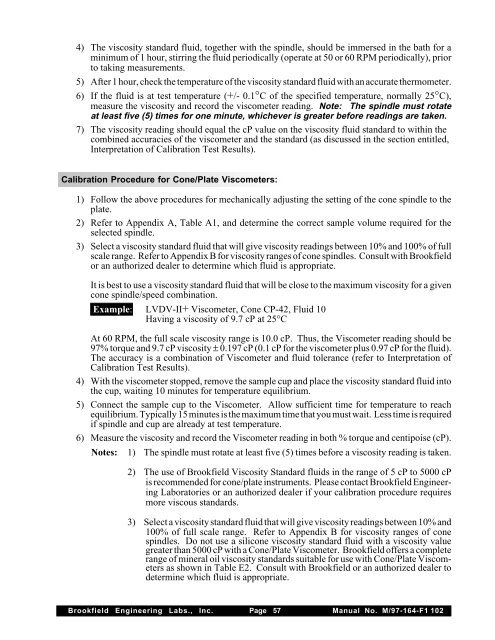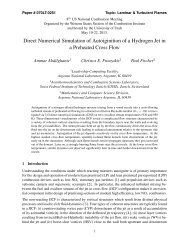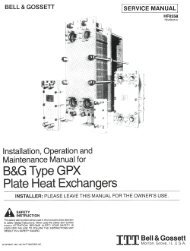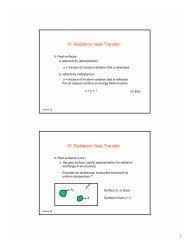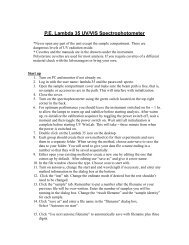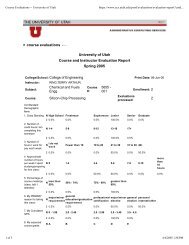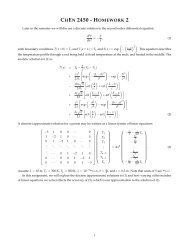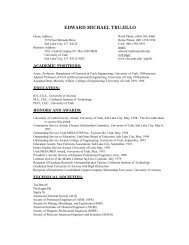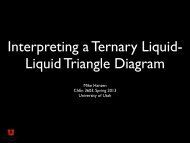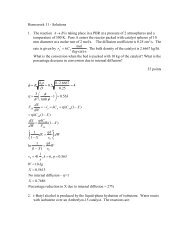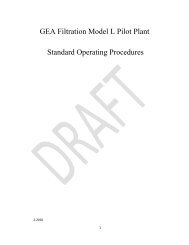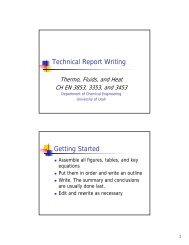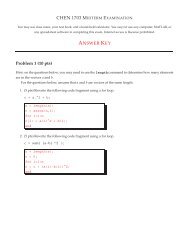BROOKFIELD DV-II+ PROGRAMMABLE VISCOMETER Operating ...
BROOKFIELD DV-II+ PROGRAMMABLE VISCOMETER Operating ...
BROOKFIELD DV-II+ PROGRAMMABLE VISCOMETER Operating ...
You also want an ePaper? Increase the reach of your titles
YUMPU automatically turns print PDFs into web optimized ePapers that Google loves.
4) The viscosity standard fluid, together with the spindle, should be immersed in the bath for aminimum of 1 hour, stirring the fluid periodically (operate at 50 or 60 RPM periodically), priorto taking measurements.5) After 1 hour, check the temperature of the viscosity standard fluid with an accurate thermometer.6) If the fluid is at test temperature (+/- 0.1°C of the specified temperature, normally 25°C),measure the viscosity and record the viscometer reading. Note: The spindle must rotateat least five (5) times for one minute, whichever is greater before readings are taken.7) The viscosity reading should equal the cP value on the viscosity fluid standard to within thecombined accuracies of the viscometer and the standard (as discussed in the section entitled,Interpretation of Calibration Test Results).Calibration Procedure for Cone/Plate Viscometers:1) Follow the above procedures for mechanically adjusting the setting of the cone spindle to theplate.2) Refer to Appendix A, Table A1, and determine the correct sample volume required for theselected spindle.3) Select a viscosity standard fluid that will give viscosity readings between 10% and 100% of fullscale range. Refer to Appendix B for viscosity ranges of cone spindles. Consult with Brookfieldor an authorized dealer to determine which fluid is appropriate.It is best to use a viscosity standard fluid that will be close to the maximum viscosity for a givencone spindle/speed combination.Example: LV<strong>DV</strong>-<strong>II+</strong> Viscometer, Cone CP-42, Fluid 10Having a viscosity of 9.7 cP at 25°CAt 60 RPM, the full scale viscosity range is 10.0 cP. Thus, the Viscometer reading should be97% torque and 9.7 cP viscosity ± 0.197 cP (0.1 cP for the viscometer plus 0.97 cP for the fluid).The accuracy is a combination of Viscometer and fluid tolerance (refer to Interpretation ofCalibration Test Results).4) With the viscometer stopped, remove the sample cup and place the viscosity standard fluid intothe cup, waiting 10 minutes for temperature equilibrium.5) Connect the sample cup to the Viscometer. Allow sufficient time for temperature to reachequilibrium. Typically 15 minutes is the maximum time that you must wait. Less time is requiredif spindle and cup are already at test temperature.6) Measure the viscosity and record the Viscometer reading in both % torque and centipoise (cP).Notes: 1) The spindle must rotate at least five (5) times before a viscosity reading is taken.2) The use of Brookfield Viscosity Standard fluids in the range of 5 cP to 5000 cPis recommended for cone/plate instruments. Please contact Brookfield EngineeringLaboratories or an authorized dealer if your calibration procedure requiresmore viscous standards.3) Select a viscosity standard fluid that will give viscosity readings between 10% and100% of full scale range. Refer to Appendix B for viscosity ranges of conespindles. Do not use a silicone viscosity standard fluid with a viscosity valuegreater than 5000 cP with a Cone/Plate Viscometer. Brookfield offers a completerange of mineral oil viscosity standards suitable for use with Cone/Plate Viscometersas shown in Table E2. Consult with Brookfield or an authorized dealer todetermine which fluid is appropriate.Brookfield Engineering Labs., Inc. Page 57 Manual No. M/97-164-F1 102


